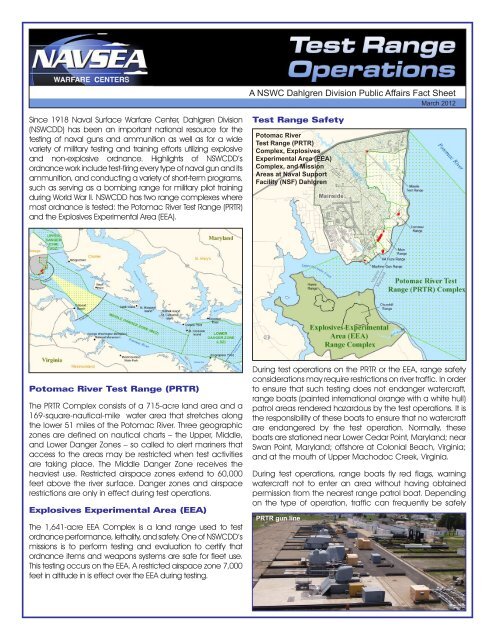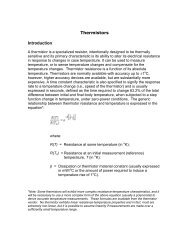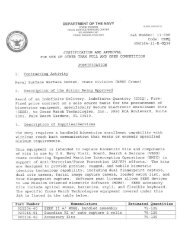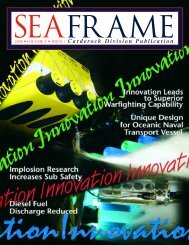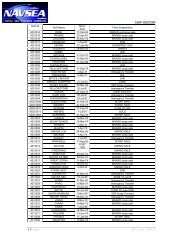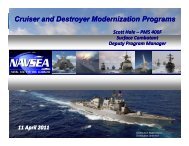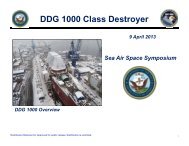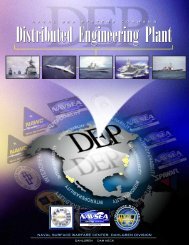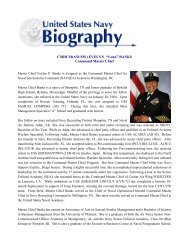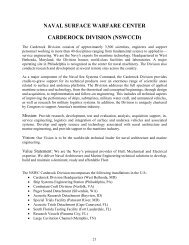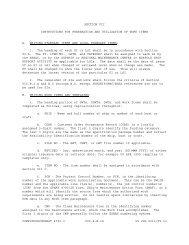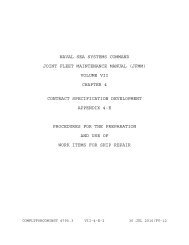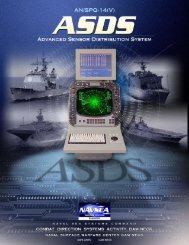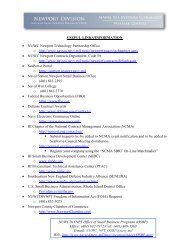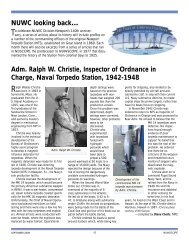Test Range Operations - Naval Sea Systems Command
Test Range Operations - Naval Sea Systems Command
Test Range Operations - Naval Sea Systems Command
You also want an ePaper? Increase the reach of your titles
YUMPU automatically turns print PDFs into web optimized ePapers that Google loves.
Since 1918 <strong>Naval</strong> Surface Warfare Center, Dahlgren Division<br />
(NSWCDD) has been an important national resource for the<br />
testing of naval guns and ammunition as well as for a wide<br />
variety of military testing and training efforts utilizing explosive<br />
and non-explosive ordnance. Highlights of NSWCDD’s<br />
ordnance work include test-firing every type of naval gun and its<br />
ammunition, and conducting a variety of short-term programs,<br />
such as serving as a bombing range for military pilot training<br />
during World War II. NSWCDD has two range complexes where<br />
most ordnance is tested: the Potomac River <strong>Test</strong> <strong>Range</strong> (PRTR)<br />
and the Explosives Experimental Area (EEA).<br />
Potomac River <strong>Test</strong> <strong>Range</strong> (PRTR)<br />
The PRTR Complex consists of a 715-acre land area and a<br />
169-square-nautical-mile water area that stretches along<br />
the lower 51 miles of the Potomac River. Three geographic<br />
zones are defined on nautical charts – the Upper, Middle,<br />
and Lower Danger Zones – so called to alert mariners that<br />
access to the areas may be restricted when test activities<br />
are taking place. The Middle Danger Zone receives the<br />
heaviest use. Restricted airspace zones extend to 60,000<br />
feet above the river surface. Danger zones and airspace<br />
restrictions are only in effect during test operations.<br />
Explosives Experimental Area (EEA)<br />
The 1,641-acre EEA Complex is a land range used to test<br />
ordnance performance, lethality, and safety. One of NSWCDD’s<br />
missions is to perform testing and evaluation to certify that<br />
ordnance items and weapons systems are safe for fleet use.<br />
This testing occurs on the EEA. A restricted airspace zone 7,000<br />
feet in altitude in is effect over the EEA during testing.<br />
A NSWC Dahlgren Division Public Affairs Fact Sheet<br />
<strong>Test</strong> <strong>Range</strong> Safety<br />
Potomac River<br />
<strong>Test</strong> <strong>Range</strong> (PRTR)<br />
Complex, Explosives<br />
Experimental Area (EEA)<br />
Complex, and Mission<br />
Areas at <strong>Naval</strong> Support<br />
Facility (NSF) Dahlgren<br />
March 2012<br />
During test operations on the PRTR or the EEA, range safety<br />
considerations may require restrictions on river traffic. In order<br />
to ensure that such testing does not endanger watercraft,<br />
range boats (painted international orange with a white hull)<br />
patrol areas rendered hazardous by the test operations. It is<br />
the responsibility of these boats to ensure that no watercraft<br />
are endangered by the test operation. Normally, these<br />
boats are stationed near Lower Cedar Point, Maryland; near<br />
Swan Point, Maryland; offshore at Colonial Beach, Virginia;<br />
and at the mouth of Upper Machodoc Creek, Virginia.<br />
During test operations, range boats fly red flags, warning<br />
watercraft not to enter an area without having obtained<br />
permission from the nearest range patrol boat. Depending<br />
on the type of operation, traffic can frequently be safely<br />
PRTR gun line
erouted around the test area. <strong>Range</strong> <strong>Operations</strong> personnel<br />
carefully minimize delays to both commercial and<br />
recreational boat traffic.<br />
Daily updates on the range<br />
operation and test schedule<br />
are available at 877-845-5656<br />
(toll free). <strong>Range</strong> <strong>Operations</strong><br />
monitors marine ship-to-shore<br />
channels 14 and 16 and<br />
will respond to requests for<br />
information. Information on<br />
the danger zone and on tests<br />
scheduled for a particular day<br />
can be found on the Web at<br />
<strong>Range</strong> patrol boat<br />
http://www.navsea.navy.mil/<br />
nswc/dahlgren/RANGE/rangeschedule.aspx.<br />
Frequency of <strong>Test</strong>ing<br />
NSWCDD typically conducts operations Monday through<br />
Friday between 8 am and 5 pm. <strong>Operations</strong> not involving<br />
ordnance may be conducted in the evening. In recent years,<br />
an average of about 4,700 rounds have been fired annually<br />
from large-caliber guns on the PRTR. Guns shoot multiple bursts<br />
or intermittent single rounds. An average of 190 detonations<br />
take place every year, primarily on the EEA. Detonations usually<br />
are heard as booms or rumbles. Because NSWCDD is able to<br />
model test firings on computers, the number of rounds fired<br />
annually has dropped by 80 percent since the 1960s.<br />
Ammunition in the Potomac River<br />
Over NSWCDD’s more than nine decades of operations,<br />
millions of rounds of ammunition have been fired or launched<br />
within the bounds of the PRTR. Most of the ammunition fired<br />
has been inert, composed of a steel case surrounding an<br />
inert filler material, such as cement. The cement replicates<br />
the weight of a live projectile. Spent projectiles typically<br />
become embedded in river sediments.<br />
When there is a requirement to test-fire explosive ammunition,<br />
the filler in the projectile is composed of explosive materials<br />
designed to detonate just above the water or upon impact<br />
with the water. As the very nature of NSWCDD’s mission is<br />
to develop and test weapons and ammunition in order to<br />
develop more effective systems, some tests fail. A small<br />
percentage of live ammunition fired over the years has<br />
failed to detonate. Such ammunition is called unexploded<br />
ordnance or UXO.<br />
Unexploded Ordnance (UXO)<br />
UXO still contains explosives, chemicals, or propellants after<br />
5”54 Gun firing downriver<br />
from gun line<br />
firing or use because<br />
the ordnance did not<br />
explode. On the PRTR,<br />
unexploded projectiles<br />
penetrate the bottom<br />
of the river and are<br />
covered with sediment<br />
and silt.<br />
The broad variety of research, development, testing,<br />
evaluation, and training activities conducted on NSWCDD’s<br />
ranges have resulted in four different types of UXO: naval<br />
gun ammunition; small explosives such as grenades;<br />
aircraft bombs; and small rockets.<br />
UXO<br />
If disturbed, UXO can explode and injure people handling<br />
it. In the event that UXO or potential UXO is located by the<br />
public in shallow water, or is found washed ashore following<br />
a storm, NSWCDD responds immediately to secure the item<br />
and safely remove it.<br />
If you find a projectile:<br />
1. DO NOT TOUCH OR ATTEMPT TO MOVE THE ITEM.<br />
2. Treat any suspected UXO as if it IS UXO – NSWCDD will<br />
provide experts who will identify and if necessary remove<br />
and properly treat the item.<br />
3. Phone the NSWCDD base operator –<br />
(540) 653-8291 – and give your name,<br />
address, phone number, and location of<br />
the suspect item.<br />
4. Mark the area (avoid direct contact with<br />
the suspect item).<br />
5. If possible, take a digital picture of the<br />
suspect item to email to the Explosives<br />
Ordnance Disposal (EOD) response team<br />
after they contact you.<br />
The base operator will contact the EOD<br />
response team – on call 24 hours a day<br />
– who will follow up with you.<br />
UXO<br />
UXO


